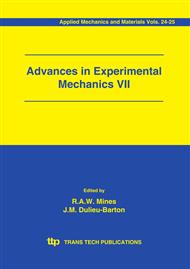[1]
D. P. Bentz. Fibers, percolation, and spalling of high-performance concrete. ACI Materials Journal, 97(3): 351-359, (2000).
DOI: 10.14359/9878
Google Scholar
[2]
T. Z. Harmathy. Effect of moisture on the fire endurance of building elements. Technical Report STP 385, American Society of Testing and Materials, (1965).
Google Scholar
[3]
P. Kalifa, G. Ch´en´e, and C. Gall´e. High temperature behaviour of HPC with polypropylene fibres: from spalling to microstructure. Cement and Concrete Research, 31: 1487-1499, (2001).
DOI: 10.1016/s0008-8846(01)00596-8
Google Scholar
[4]
G. A. Khoury, B. N. Grainger, and P. J. E. Sullivan. Strain of concrete during first heating to 600◦C. Magazine of Concrete Research, 37(133): 195-215, 1985. 10.
DOI: 10.1680/macr.1985.37.133.195
Google Scholar
[5]
W. Kusterle, W. Lindlbauer, G. Hampejs, A. Heel, P. -F. Donauer, M. Zeiml, W. Brunnsteiner, R. Dietze, W. Hermann, H. Viechtbauer, M. Schreiner, R. Vierthaler, H. Stadlober, H. Winter, J. Lemmerer, and E. Kammeringer. Brandbest¨andigkeit von Faser-, Stahl- und Spannbeton.
Google Scholar
[6]
C. Meyer-Ottens. Zur Frage der Abplatzungen an Betonbauteilen aus Normalbeton bei Brandbeanspruchung.
Google Scholar
[7]
¨Osterreichisches Normungsinstitut. Beton - Teil 1: Festlegung, Herstellung, Verwendung und Konformit¨atsnachweis [Concrete - Part 1: Specification, production, use and verification of conformity], 2004. In German.
Google Scholar
[8]
P. Paulini and F. Nasution. Air permeability of near surface concrete. In F. et al. Toutelemonde, editor, Proceedings of the 5th International Conference on Concrete Under Severe Conditions: Environment and Loading (CONSEC'07), pages 241-248, Paris, 2007. Laboratoire central des ponts et chaussees (LCPC).
Google Scholar
[9]
L. T. Phan and N. J. Carino. Review of mechanical properties of HSC at elevated temperatures. Journal of Materials in Civil Engineering, 10(1): 58-64, (1998).
Google Scholar
[10]
U. Schneider. Ein Beitrag zur Frage des Kriechens und der Relaxation von Beton unter hohen Temperaturen [Contribution to creep and relaxation of concrete under high temperatures]. Habilitation thesis, TU Braunschweig, Braunschweig, Germany, 1979. In German.
Google Scholar
[11]
U. Schneider. Concrete at high temperature - a general review. Fire Safety Journal, 13: 55-68, (1988).
Google Scholar
[12]
U. Schneider and J. Horvath. Abplatzverhalten an Tunnelinnenschalenbeton [Spalling of concrete for tunnel linings]. Beton- und Stahlbetonbau, 97(4): 185-190, 2002. In German.
DOI: 10.1002/best.200200860
Google Scholar
[13]
S. Thelandersson. Modeling of combined thermal and mechanical action in concrete. Journal of Engineering Mechanics (ASCE), 113(6): 893-906, (1987).
DOI: 10.1061/(asce)0733-9399(1987)113:6(893)
Google Scholar
[14]
M. Zeiml, R. Lackner, D. Leithner, and J. Eberhardsteiner. Identification of residual gastransport properties of concrete subjected to high temperatures. Cement and Concrete Research, 38(5): 699-716, 2008. 11.
DOI: 10.1016/j.cemconres.2008.01.005
Google Scholar


